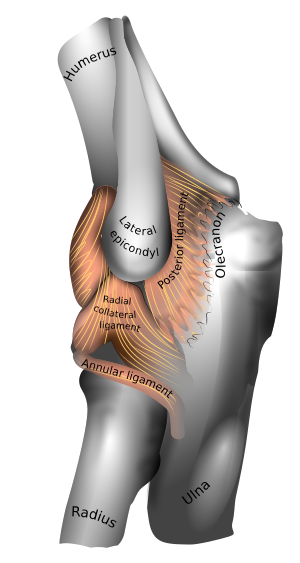Tennis Elbow
Tennis elbow, also known as lateral epicondylitis or enthesopathy of the extensor carpi radialis origin, is a condition characterised by pain and tenderness on the outer part of the elbow. It is an enthesopathy affecting the origin of the extensor carpi radialis brevis on the lateral epicondyle. The pain can extend into the back of the forearm and is usually gradual in onset. Despite its name, tennis elbow is not restricted to tennis players and can affect anyone, particularly those aged between 35 and 60.

Signs and Symptoms
The primary symptoms of tennis elbow include pain on the outer part of the elbow and point tenderness over the lateral epicondyle. Pain may be exacerbated by activities involving wrist extension or passive wrist flexion. Common signs are:
- Pain with resisted wrist extension.
- Point tenderness over the lateral epicondyle.
- Pain radiating from the outer elbow to the forearm and wrist.
Causes
Enthesopathy of the extensor carpi radialis brevis origin is idiopathic, meaning it has no known cause. Traditionally, it was thought to be a repetitive strain injury from tendon overuse, but there is no experimental evidence to support this. Speculative risk factors include taking up tennis later in life, unaccustomed strenuous activity, decreased mental chronometry and speed, and repetitive eccentric muscle contractions.


Pathophysiology
Histological findings reveal mucoid degeneration, disorganised collagen, increased extracellular matrix, and chondroid metaplasia, with no evidence of inflammation or repair. This makes "tendinosis" or "tendinopathy" more appropriate terms than "tendinitis."
Diagnosis
Physical Examination
Diagnosis is primarily based on symptoms and clinical signs, including point tenderness at the extensor carpi radialis brevis origin and pain with resisted wrist extension. Cozen's test is a specific physical examination for tennis elbow, where resisted wrist extension triggers pain on the lateral aspect of the elbow.
Medical Imaging
Medical imaging is generally not necessary. Radiographs may show calcification at the extensor muscle origin, and ultrasonography or MRI can reveal tendon changes but are not essential for diagnosis or treatment.
Treatment
The natural history of untreated tennis elbow is resolution within 1-2 years. Palliative treatments include NSAIDs, acetaminophen, wrist braces, or upper forearm straps.
Exercises
Stretching and isometric strengthening exercises are commonly recommended. Stretching involves passively flexing the wrist with the elbow straight, while isometric strengthening can be done by pushing the top of the hand against a table.
Orthotic Devices
Orthotics, such as counterforce and wrist extensor orthoses, may reduce pain and improve function. Counterforce orthoses apply pressure over the wrist extensors' origin, reducing elongation, while wrist extensor orthoses maintain the wrist in slight extension.


Medications
Though commonly prescribed, anti-inflammatories have mixed evidence for effectiveness. Topical NSAIDs may offer short-term pain relief, but the benefits of oral NSAIDs and corticosteroid injections are inconsistent.
Surgery
Surgery is considered if other treatments fail. Techniques include lengthening, release, debridement, or repair of the extensor muscles' origin. However, evidence for the efficacy of surgery over other treatments is limited and side effects include infection, nerve damage, and reduced arm mobility.
Epidemiology
Evidence suggests that about 1 in 5 people will experience enthesopathy of the extensor carpi radialis brevis origin in their lifetime, with symptoms most common between ages 40 and 60. The condition is not conclusively linked to specific occupations or sports.
History
The condition was first described by German physician F. Runge in 1873 as "writer's cramp." It later became known as "washer women's elbow" and "lawn tennis arm." The term "tennis elbow" was popularised in 1883 by British surgeon Henry Morris and H. P. Major.
Self-assessment MCQs (single best answer)
What is another name for tennis elbow?
Which muscle's origin is primarily affected in tennis elbow?
What is the primary symptom of tennis elbow?
Which test is specifically used to diagnose tennis elbow?
Which of the following is NOT a common treatment for tennis elbow?
What is the natural history of untreated tennis elbow?
Which of the following is a speculative risk factor for developing tennis elbow?
Which histological finding is associated with tennis elbow?
What is a counterforce orthosis used for in the treatment of tennis elbow?
Who first described the condition known as tennis elbow?
Dentaljuce
Dentaljuce provides Enhanced Continuing Professional Development (CPD) with GDC-approved Certificates for dental professionals worldwide.
Founded in 2009 by the award-winning Masters team from the School of Dentistry at the University of Birmingham, Dentaljuce has established itself as the leading platform for online CPD.
With over 100 high-quality online courses available for a single annual membership fee, Dentaljuce offers comprehensive e-learning designed for busy dental professionals.
The courses cover a complete range of topics, from clinical skills to patient communication, and are suitable for dentists, nurses, hygienists, therapists, students, and practice managers.
Dentaljuce features Dr. Aiden, a dentally trained AI-powered personal tutor available 24/7 to assist with queries and provide guidance through complex topics, enhancing the learning experience.
Check out our range of courses, or sign up now!


